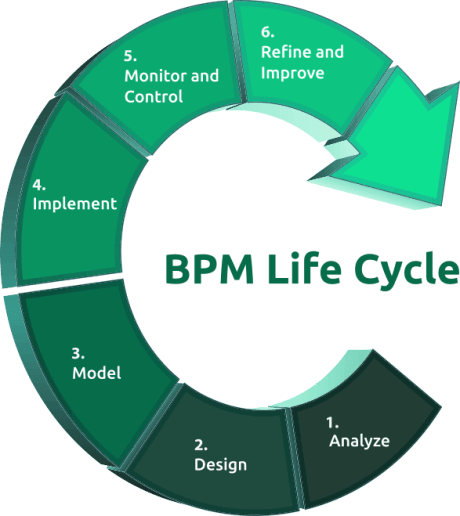What is Business Process Management (BPM)?
Business Process Management (BPM) is a methodology used by organizations to create, manage and improve their processes. BPM involves analyzing each process on its own, while also considering the part it plays within the organization. A key part of BPM is the frequent fine-tuning of processes, with the aim of optimizing as much as possible. This could be as easy as removing a step in a process or rebuilding the entire process from start to finish.
Before we talk more about business process management, we should firstly define what a process is within the context of BPM.
A business process is a series of repeatable steps designed to achieve a goal. Repetition is the key aspect of business processes. They should be performed regularly and done in a similar way each time. Some examples of business processes are:
- New employee onboarding
- Code release
- Handling a customer complaint
- Product assembly
- Finance application
Now that you understand what a business process is, we can explain how BPM works using the Business Process Management Life Cycle.
The BPM Life Cycle is an iterative set of activities done in six phases. This means that the cycle can be repeated, instead of ending once the final phase is over.
The six phases are:
- Analyze
- Design
- Model
- Implement
- Monitor and Control
- Refine and Improve

You should analyse each business process for its effectiveness and optimization. Start by ensuring that the process is aligned with the goals and objectives of the organization. Then you can take a closer look at each step in the process to see what is working and what isn’t. Analysis will identify opportunities for improvement and help you to understand how the improved process could impact the overall performance of the organization.
Now that you have identified some opportunities for improvement you can begin to develop some ideas for how to improve and optimize the process. This could be as complicated as implementing automation to remove a manual step, or it could be as simple as removing a redundant step. The main concern in this phase is to determine whether the process is good “as is”, or if it should be redesigned in a better, more refined “to be” process.
You can now put your designs in to action or simulate how the changes would impact the process and the entire organization. Modelling techniques can vary depending on the process that is being refined. However, running test-cases and prototypes are good ways to see how the proposed changes perform. This phase is important for refining your design ideas and turning your concepts into actionable changes.
Once the modelling has proven that the proposed changes have a positive impact on the process and the organization at large, it’s time to implement your modifications. Implementation of new processes or modified processes is best done using software that allows you to easily create and edit your processes. Ideally, the software you use will also have full version history so that you can revert back to a previous version of your process if required.
Once your process has been implemented you will need to monitor and control it to ensure that it is working properly. The software you use should be able to tell you when a process has started, what the current status of the process is, who is working on the process, is the process running on schedule etc. All of this information will allow you to take action if necessary. This is especially important to business critical or time sensitive processes.
Through monitoring and control of process performance, the organization will be able to innovate and improve its processes primarily through redesign and reengineering.
Once your implementation has been completed successfully it’s time to start from the beginning again. A key part of BPM is to constantly look for ways to improve. Businesses stagnate when they stand still, and properly executed BPM pushes organizations towards new horizons.
Software utilization is the best way to implement effective business process management. CheckFlow is the best BPM software for covering all six phases of the BPM life cycle.
Here are some reasons why CheckFlow is the best all-in one BPM solution:
- Easily design and create your processes using a drag and drop template designer.
- Refine and improve your processes. View previous versions of a process and revert back if required.
- Simplify your processes using powerful checklists.
- Display a wide range of information and collect an unlimited amount of data within your process checklists.
- Link checklists to simplify large processes. Start them automatically and link data within each process to further automate and simplify your workflow.
- Utilize other advanced workflow features, such as: Dynamic Due Dates, Halt Tasks and Conditional Logic to further customize your workflow.
- Collaborate easily by adding comments to tasks and mentioning other team members, or by assigning tasks to others.
- Access and complete your checklists on your mobile device.
- Automate and integrate with other apps.
- Monitor, manage and analyze your processes.
All your business processes can flow through CheckFlow, which can serve as your central hub. It lets you analyse each process and determine if delays exist. Then you will have an easier time optimizing and managing processes.
Sign up for a free trial today.